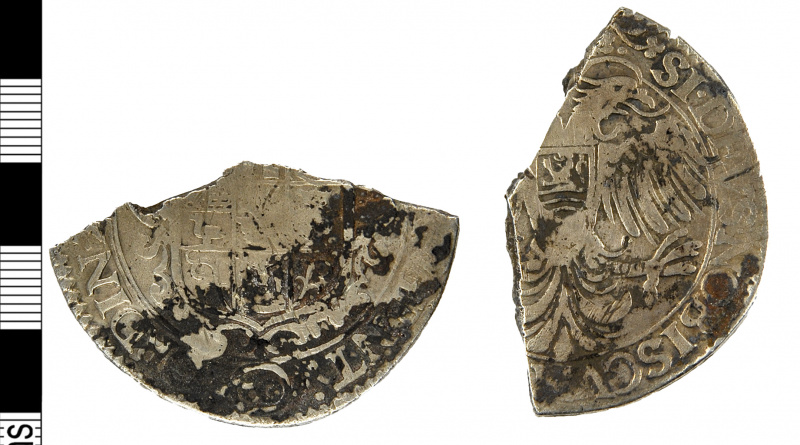Arendsdaalder
About a third of an Arendsdaalder of the Dutch republic. The Arendsdaalder was worth 60 groot or 11/2 guilders, which was the main unit of account. The PAS record says that this is only the second Arendsdaalder to be recorded on the database and has been designated a Find of Note of Regional Importance.
Arendsdaalder
The Arendsdaalder gets its name from the eagle on the obverse (“Arend” means “Eagle” in Dutch) and “daalder” meaning dollar. They were minted in

As shown in this full coin, the double-headed eagle on the obverse has the crest of Zeeland on its chest. This is a lion emerging from the waves can bee seen accompanied by the text luctor et emergo (“I struggle and emerge”) on the full coat of arms.
The obverse legend reads “SI.DEVS.NOBISCVM.QVIS.CONtra.NOS” – if god is with us, who is against us.
On the reverse is a large escutcheon of the cities of County of Zeeland, including Middelburg (top, centre). The legend reads MONETA•ARGENT.ORDIN(um)•ZEELANDIA – Silver money ordered by Zeeland. The value of 60 groots is shown inside a cartouche at the bottom.
Middelburg mint
The Middelburg mint in Zeeland was set up soon after the Dutch Republic was formed in 1579, following a revolt by seven Dutch provinces against rule by Spain. The success of the mint infuriated Holland, the largest of the seven provinces, and imprisoned the mint master. Realising that it would be better to have Zeeland as an ally against Spain, they eventually released him.
On 20 November 1601, the mint master, Melchior Wijntgens, was given instructions to mint daalders. These had previously been a unit of account but not an actual coin. Also produced were 2/3 (= guilders), 1/3, 1/6 and 1/12 daalders. Therefore, cutting this find into thirds made some sort of sense from a monetary viewpoint but would have been somewhat difficult to execute, as shown by the rough edges.
Production took place from 5 February 1602 until 25 April 1603, with all these coins dated 1602. Production briefly resumed in 1618-1619.

